Physical Address
304 North Cardinal St.
Dorchester Center, MA 02124
Inhaled anesthetics affect every part of physiology of the lungs and their pulmonary pharmacology is complex.
Volatile anesthetics produce bronchodilation through decreases in cytoplasmic ionized calcium concentration and/or a reduction in calcium sensitivity of airway smooth muscle. Volatile anesthetics also attenuate an increase in pulmonary airway resistance induced by chemical and mechanical stimulation.
Inhaled anesthetics reduce the rate of mucous clearance and affect function of type II alveolar cells; these effects can potentially contribute to postoperative pulmonary complications.
Volatile anesthetics produce a biphasic response in pulmonary vascular smooth muscle. Although inhibition of hypoxic pulmonary vasoconstriction by volatile anesthetic is an overall small effect, it can contribute to worsening of hypoxemia in patients with underlying pulmonary disease.
Volatile anesthetics depress respiratory function through a diminished respiratory drive and an increase in upper airway collapsibility. Following extubation, even at residual concentrations, volatile anesthetics can severely impair peripheral chemoreceptor inputs and hypoxic arousal reflexes.
Volatile anesthetics produce dose-dependent reductions in tidal volume and minute ventilation, cause tachypnea, and blunt ventilatory response to hypercapnia and hypoxia.
During anesthesia with volatile agents, diaphragmatic function remains relatively well preserved, whereas inspiratory rib cage muscles are significantly depressed resulting in insufficiency of breathing or paradoxical breathing.
Volatile anesthetics can compromise upper airway patency. Even at low concentrations, upper airway obstruction can occur in susceptible patients, including elderly, obese, or critically ill patients.
Volatile anesthetics vary in their ability to irritate airways and augment defensive airway reflexes. Sevoflurane causes the least amount of subjective airway irritation and is the anesthetic of choice for inhaled induction of anesthesia in infants and children.
Preclinical and clinical evidence suggests therapeutic potential of isoflurane and sevoflurane in acute lung injury.
Although concerns have been recently raised regarding the use of nitrous oxide, a lack of strong evidence does not justify abandoning it from clinical practice, especially considering its favorable cost-effectiveness.
Xenon produces a fast on and off action and is a promising alternative for sedation in the critical care setting.
This chapter is a consolidation of two chapters in the eighth edition, Chapter 27 Inhaled Anesthetics: Pulmonary Pharmacology and Chapter 28 Inhaled Anesthetics: Cardiovascular Pharmacology. The editors and publisher would like to thank the following authors: Neil E. Farber, Eckehard A.E. Stuth, Astrid G. Stucke, and Paul S. Pagel for their contributions to the prior edition of this work. It has served as the foundation for the current chapter.
Pulmonary pharmacology of inhaled anesthetics is complex. This chapter focuses in depth on pulmonary pharmacology of isoflurane, sevoflurane, desflurane, nitrous oxide, and xenon. The older anesthetics (including halothane, enflurane, and ether) are no longer in use in the developed countries, and are discussed here only for comparison. The lungs are unique in their exposure to a wide variety of physical forces including ventilation, blood flow, and surface tension as well as derangements of function caused by disease and environmental factors. The effects of inhaled anesthetics on ventilatory control, airway tone, mucociliary function, surfactant production, pulmonary vascular resistance (PVR), and acute lung injury (ALI) are examined in detail in this chapter.
The physical properties of commonly used inhalational anesthetics and clinical concerns are presented in Table 21.1 .
| Property | Halothane | Isoflurane | Sevoflurane | Desflurane | Nitrous oxide | Xenon |
|---|---|---|---|---|---|---|
| Boiling point (°C) | 50.2 | 49 | 59 | 24 | −88 | −108 |
| Vapor pressure (mm Hg) at 20°C | 241 | 238 | 157 | 669 | 38,770 | – |
| Blood:gas partition coefficient | 2.5 | 1.46 | 0.65 | 0.42 | 0.46 | 0.115 |
| Oil:gas partition coefficient | 224 | 91 | 47 | 19 | 1.4 | 1.9 |
| Minimal alveolar concentration (MAC) | 0.74 | 1.17 | 1.8 | 6.6 | 104 | 63-71 |
| Metabolized in the body (%) | 25 | 0.2 | 2-4 | 0.02 | 0 | 0 |
| Clinical concerns | Hepatotoxicity | Compound A | Airway irritation | Gas expansion | Apnea |
Asthma is a chronic airway disease with an estimated worldwide annual death rate of 250,000. Asymptomatic asthma patients have relatively infrequent perioperative respiratory complications; however, bronchospasm develops in about 9% of asthmatics in the perioperative period. Twenty-five percent of asthmatics may present with wheezing after induction of anesthesia, and 1.7% of asthma patients sustain a poor respiratory outcome. In addition, acute bronchospasm can occur at induction, intubation, or during maintenance of anesthesia without prior history of asthma or COPD. According to the ASA Closed Claims Project 40 cases of bronchospasm resulted in settled malpractice claims, with 88% involving brain damage or death. Importantly, only half of the patients had preexisting asthma or COPD. Adverse respiratory events accounted for 28% of claims related to anesthesia-related brain damage and death in the United States; they were associated with the highest mean cost per closed claim. In France, 7% of anesthesia-related deaths were also attributed to bronchospasm. A nonallergic mechanism was involved in nearly 80% of cases. Although bronchospasm caused by airway irritation occurred more frequently in patients who had one or more predisposing factors including asthma, heavy tobacco smoking, or bronchitis, only 50% and 60% of patients with nonallergic and allergic bronchospasm, respectively, had history of asthma.
Airway resistance is increased, at least in part, by an increase in bronchiolar smooth muscle (BSM) tone. BSM extends down to the terminal bronchioles and is controlled primarily by autonomic nervous system activity. Nonadrenergic, noncholinergic mechanisms, activated by the stimulation of the afferent bronchopulmonary sensory C fibers, play a role in BSM constriction to tachykinins, vasoactive intestinal peptide (VIP), adenosine, and calcitonin gene-related peptides.
Asthmatic bronchiolar constriction involves complex interactions of airway nerves, smooth muscle, epithelium, and inflammatory cells. In contrast, reflex bronchoconstriction caused by airway irritation is mediated by sensory afferents in the nucleus of the solitary tract (NTS), projecting to vagal preganglionic neurons (VPN). Glutamate modulates stimulation of NTS and VPN, whereas γ aminobutyric acid (GABA) is inhibitory from NTS projecting to VPN. VPN projections to the airways release acetylcholine (ACh) predominantly onto M3 receptors, inducing bronchoconstriction. Baseline airway tone is also mediated by the vagus nerve. The muscarinic acetylcholine receptors (mAChRs, M1-M5) on BSM are G protein-coupled receptors, three of which (M1, M2, and M3) are expressed in the lungs of humans and of most mammals. Belmonte and colleagues reviewed the essentials of muscarinic control of mAChRs in the lungs. Neuronal inhibitory M2 muscarinic ACh receptors on parasympathetic nerves are responsible for limiting ACh release from these nerves ( Fig. 21.1 ).
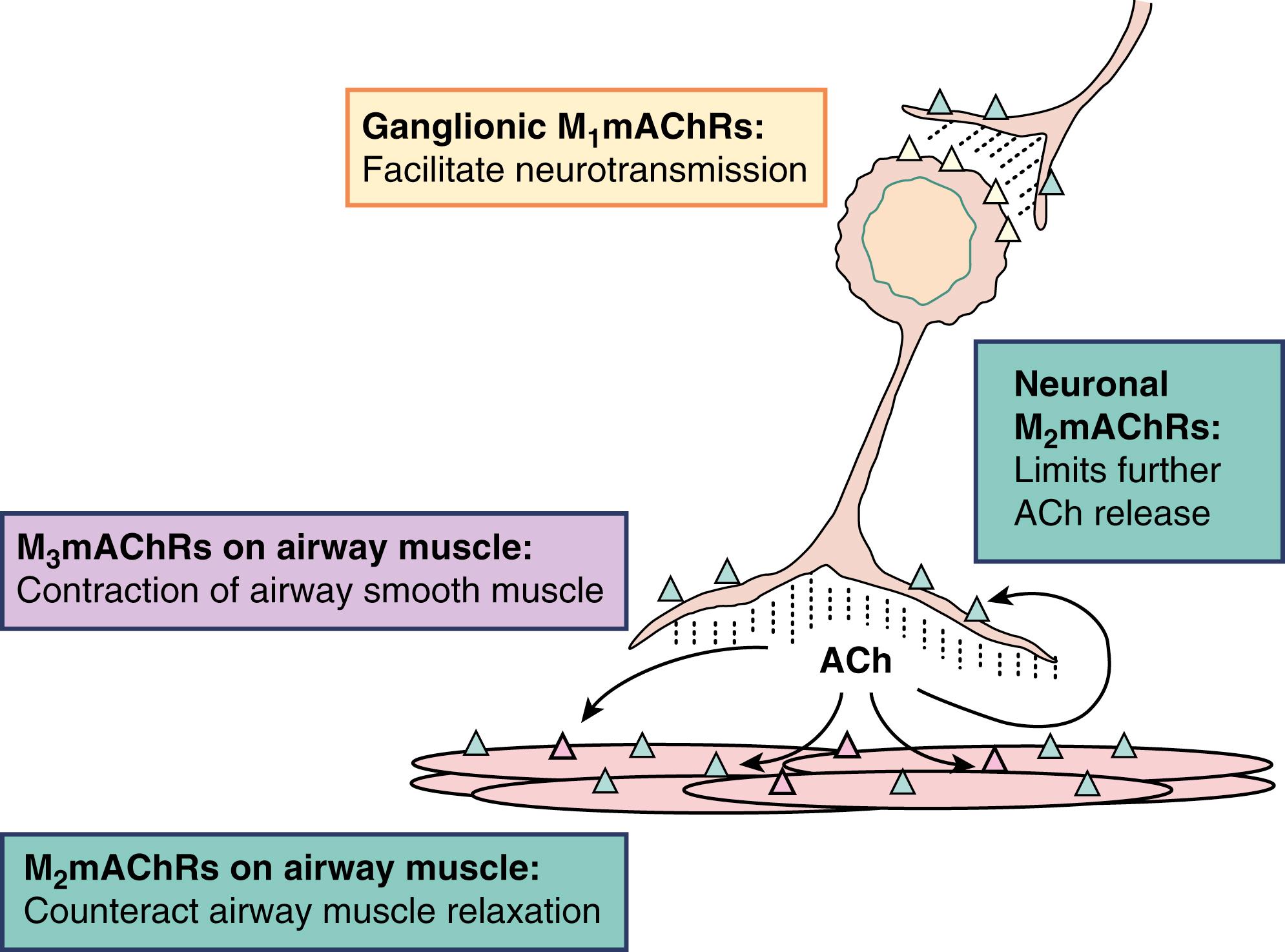
Alterations in cytoplasmic ionized calcium concentration (ICa +2 ) and calcium (Ca +2 ) influx result from the interplay of cyclic nucleotides in BSM that alters myosin light chain (MLC) and MLC kinase activity. Ca +2 /calmodulin-dependent MLC kinase is critical for tonic smooth muscle contraction. Agonist activation of BSM also involves a second messenger, cADP ribose, resulting in inositol triphosphate (IP 3 )-mediated release of Ca +2 from sarcoplasmic reticulum via activated ryanodine channels. This release is followed by an increase in sodium (Na + ) influx across the cell membrane. This localized increase in Na + may switch the Na + /Ca 2+ exchanger into reverse mode, leading to even more Ca 2+ influx and greater bronchial constriction. Several different cyclic adenosine monophosphate (cAMP) signaling compartments exist in airway smooth muscle that are responsive to different hormones and neurotransmitters. The mechanical stretch of human BSM cells also causes contraction via an influx of Ca 2+ through unique stretch-activated nonselective cation channels. Adenosine indirectly enhances contraction of airway smooth muscle via the activation of mast cells and via nerves by directly stimulating adenosine type I receptors on airway smooth muscle, thereby rapidly mobilizing ICa 2+ stores through G proteins and IP 3 signaling. Agonist-induced stimulation of particulate guanylyl cyclase relaxes bronchial smooth muscle by attenuating inward Ca 2+ current, whereas stimulation of soluble guanylyl cyclase by substances such as nitric oxide (NO) reduces ICa 2+ concentration and Ca 2+ sensitivity.
Release of histamine in the airway produces reflex bronchoconstriction from actions on H1 receptors on BSM, eliciting activation of phospholipase C and protein kinase C (PKC) downstream mediators, leading to release of Ca 2+ from intracellular stores. This leads to calcium ion entry through calcium channels, cation channels of the transient receptor potential (TRP1) channel type, and stimulation of a Na + / Ca 2+ exchanger. Nicotinic acid adenine dinucleotide phosphate has also been suggested as a potential second messenger in histamine-induced Ca 2+ release from lysosome-like acidic compartments, functionally coupled to the endoplasmic reticulum via H1 receptor in endothelial cells. This increase in bronchomotor tone is attenuated by the cholinergic antagonist atropine. The histamine-degrading enzyme, histamine N-methyltransferase, has been localized to human airway epithelium and may play a protective role against histamine-mediated bronchoconstriction. Histamine-induced bronchoconstriction, measured as altered pulmonary resistance (RL) and dynamic pulmonary compliance (C dyn ) in response to intravenous (IV) histamine was studied in dogs to determine the bronchodilatory effects of halothane, sevoflurane, isoflurane, and enflurane. All the volatile anesthetics demonstrated an inhibitory effect on increases in RL and decreases in C dyn caused by histamine.
Adrenergic receptors in BSM are classified into α and β 2 types. The α2 agonists clonidine and dexmedetomidine have been shown to produce bronchodilation in central airways, which may be mediated through α2 central vagolytic effects. Clinically, the β 2 -receptor subtypes play an important role in BSM responsiveness. Stimulation of β 2 adrenoceptors causes cAMP-mediated relaxation via activation of protein kinase A and subsequent Ca 2+ efflux out of the cell and into the SR. Interestingly, asthma, as well as allergy- and methacholine-induced bronchospasm, do not appear to be genetically linked to a dominant β 2 -adrenoceptor gene.
Respiratory epithelium releases substances that modulate BSM tone. Removal of the epithelium enhances contractile responses to ACh, histamine, or serotonin in large airways and decreases relaxation responses to isoproterenol in small airways. These responses are similar to the effect of endothelial damage on vascular smooth muscle tone. Notably, cardiopulmonary bypass does significantly affect porcine bronchiolar epithelium-mediated bronchomotor activity, in contrast to vascular endothelium-mediated smooth muscle dysfunction. While endogenous epithelial factors have been identified, endogenous NO produced in respiratory epithelium likely plays a bronchodilatory role similar to that of vascular endothelium. Endothelin-1 is a potent constrictor of vascular smooth muscle and BSM that activates the IP 3 pathway and produces greater pulmonary effects compared to the systemic circulation. Clinically, evaluation of the effects of the inhalational agents may be framed against a background of the major physiologic mechanisms governing normal and pathophysiologic BSM activity. These include airway disease (asthma and COPD), the overarching complex chemistry of calcium release as the BSM stimulus-contraction coupler, intrinsic factors (afferent and efferent ACh signaling, α2 receptor signaling, NO and endothelin-1, allergy and histamine release), and extrinsic factors (physical and chemical irritants, e.g., endotracheal tubes), capable of promoting reflex bronchoconstriction.
In general, all volatile anesthetics are bronchodilators, making them a good choice for patients with increased airway resistance. Using computed tomography (CT), Brown and colleagues demonstrated that halothane causes dose-dependent bronchodilation in a dog ( Fig. 21.2 ).
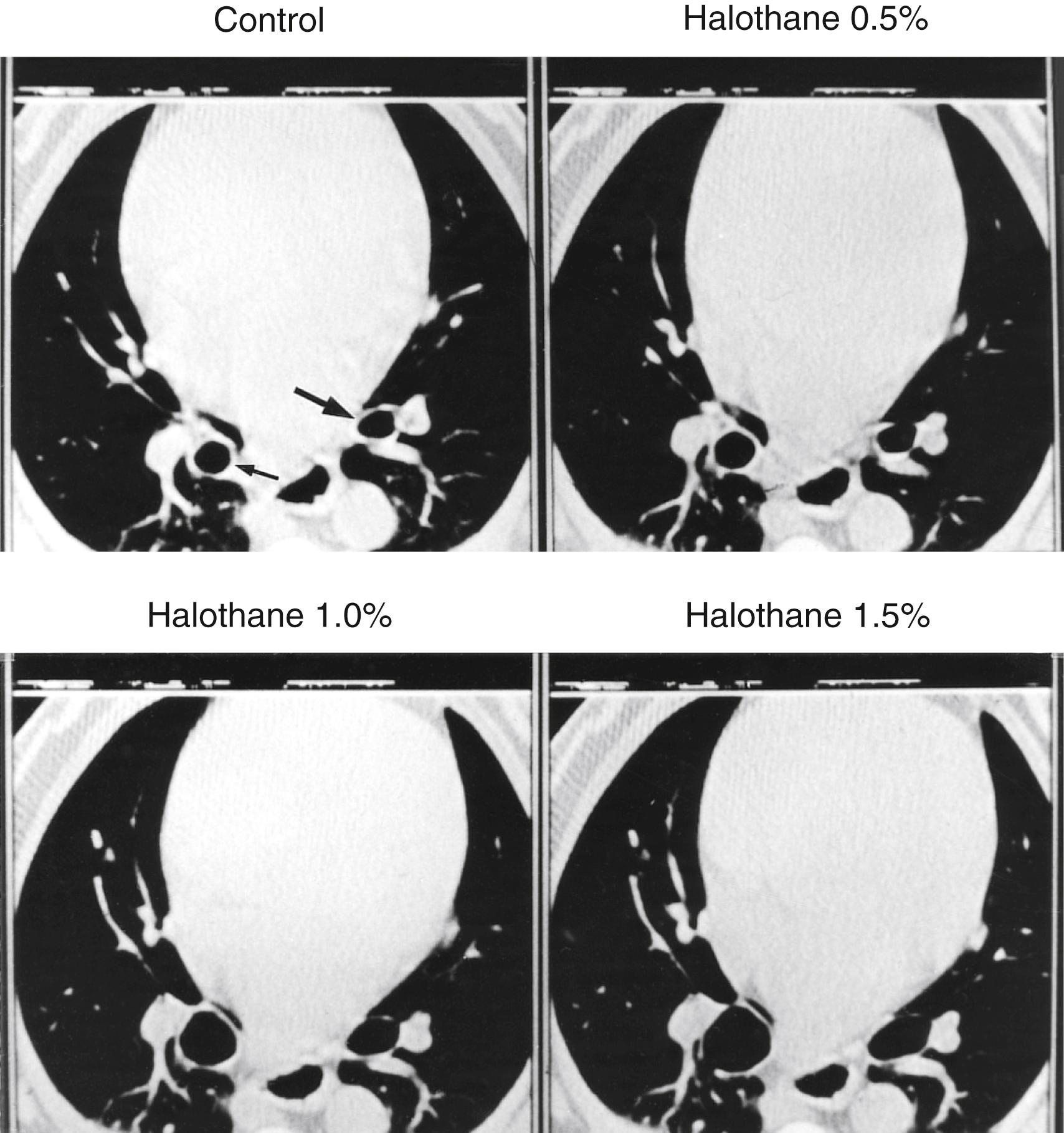
Eliminating indirect effects of arterial carbon dioxide (CO 2 ) tension is important when examining the actions of volatile anesthetics on bronchial tone, especially during spontaneous ventilation. This is because hypercapnia-induced bronchodilation and hypocapnia-induced bronchoconstriction are both attenuated by isoflurane. Thus a concentration-dependent bronchodilator effect of volatile anesthetics may be indirectly attributable to increase in CO 2 tension. The structure of the respiratory epithelium changes from pseudostratified columnar cells of the large airways to thinner, cuboidal cells of the bronchioles, and thus a relatively large amount of histologic heterogeneity exists between these regions. The specific effects of volatile anesthetics on the bronchioles depend on the location in and the structure of the respiratory tree. In vitro, isoflurane preferentially relaxes the bronchioles rather than the bronchi. Isoflurane and halothane dilate fourth order bronchi at equivalent minimum alveolar concentration (MAC) values. Similarly, at up to 1 MAC, isoflurane, sevoflurane, and desflurane attenuate methacholine-induced bronchoconstriction in open-chest, pentobarbital-anesthetized rats. Isoflurane and sevoflurane also appear to have greater inhibitory effects on bronchial contraction as compared with tracheal smooth muscle contraction. Furthermore, halothane, desflurane, and isoflurane relax distal airways (e.g., bronchioles) to a greater extent than proximal airways (e.g., bronchi). These differential effects appear to be related to the type of voltage-dependent Ca 2+ (VDC) channels that are present in these regions.
Inhalation of 1 or 2 MAC halothane, enflurane, sevoflurane, and isoflurane did not alter baseline pulmonary resistance and dynamic pulmonary compliance, but these anesthetics significantly attenuated increases in airway resistance and decreases in dynamic respiratory compliance in response to intravenous histamine. Halothane was the most effective bronchodilator, whereas responses to isoflurane, enflurane, and sevoflurane were similar. In an isolated lung model, desflurane produced bronchodilation at 1 MAC but increased airway resistance at 2 MAC, presumably resulting in part from significant increases in inspired gas density at higher MAC. Isoflurane, sevoflurane, and desflurane at 1.0, 1.5, and 2.0 MAC in 25% O 2 were all examined in a two-chamber test lung model with fixed resistance. All anesthetics demonstrated increased density and calculated resistance at higher MAC, with desflurane producing the highest increase in resistance at 2.0 MAC. In a randomized clinical trial evaluating the same agents at 1.0 and 1.5 MAC, total inspiratory resistance (R[rs]), minimal resistance (R[min]), and effective resistance (D[Rrs]) were calculated using the end-inspiratory occlusion technique. No significant differences of those parameters were observed during administration of the three agents at 1 MAC for 30 min. At 1.5 MAC, desflurane caused a maximum increase in R(rs) by 26% and in R(min) by 30% above baseline, in contrast to isoflurane and sevoflurane, which did not have a significant effect on R(rs) and R(min). Presumably, this increased resistance is due at least in part to the greater net viscosity of the higher absolute concentration of desflurane at 1.5 MAC. Other factors may also cause the reduction in the bronchodilation of desflurane at higher concentrations, especially in smokers. Halothane, enflurane, and sevoflurane are equivalent at dilating third- or fourth-generation bronchi as directly measured with a fiberoptic bronchoscope in vivo.
It appears that desflurane can both augment or inhibit bronchoconstriction (see below). At 1 MAC desflurane and sevoflurane blocked, to a similar degree, the increase in central airway resistance after a cholinergic challenge in rabbits. Both anesthetics reduced basal bronchial tone by 30% to 40%. This effect was consistently observed in the presence or absence of allergic airway inflammation and bronchial hyperresponsiveness. When the mechanism of constriction is centrally mediated, such as with a cholinergic challenge, desflurane appears to play a beneficial role in attenuating bronchoconstriction. However, when the mechanism of airway constriction is due to nonadrenergic, noncholinergic activation with tachykinins, desflurane may augment and worsen constriction. Thus clinicians tend to avoid using desflurane in patients with reactive airway disease.
Sevoflurane (1 MAC) reduced respiratory system resistance by 15% in patients undergoing elective surgery, whereas desflurane had no effect. Rooke and associates compared the bronchodilating effects of halothane, isoflurane, sevoflurane, desflurane, and thiopental–nitrous oxide in healthy patients undergoing induction of anesthesia and tracheal intubation. In contrast to thiopental–nitrous oxide, all volatile agents with the exception of desflurane significantly reduced respiratory resistance ( Fig. 21.3 ).
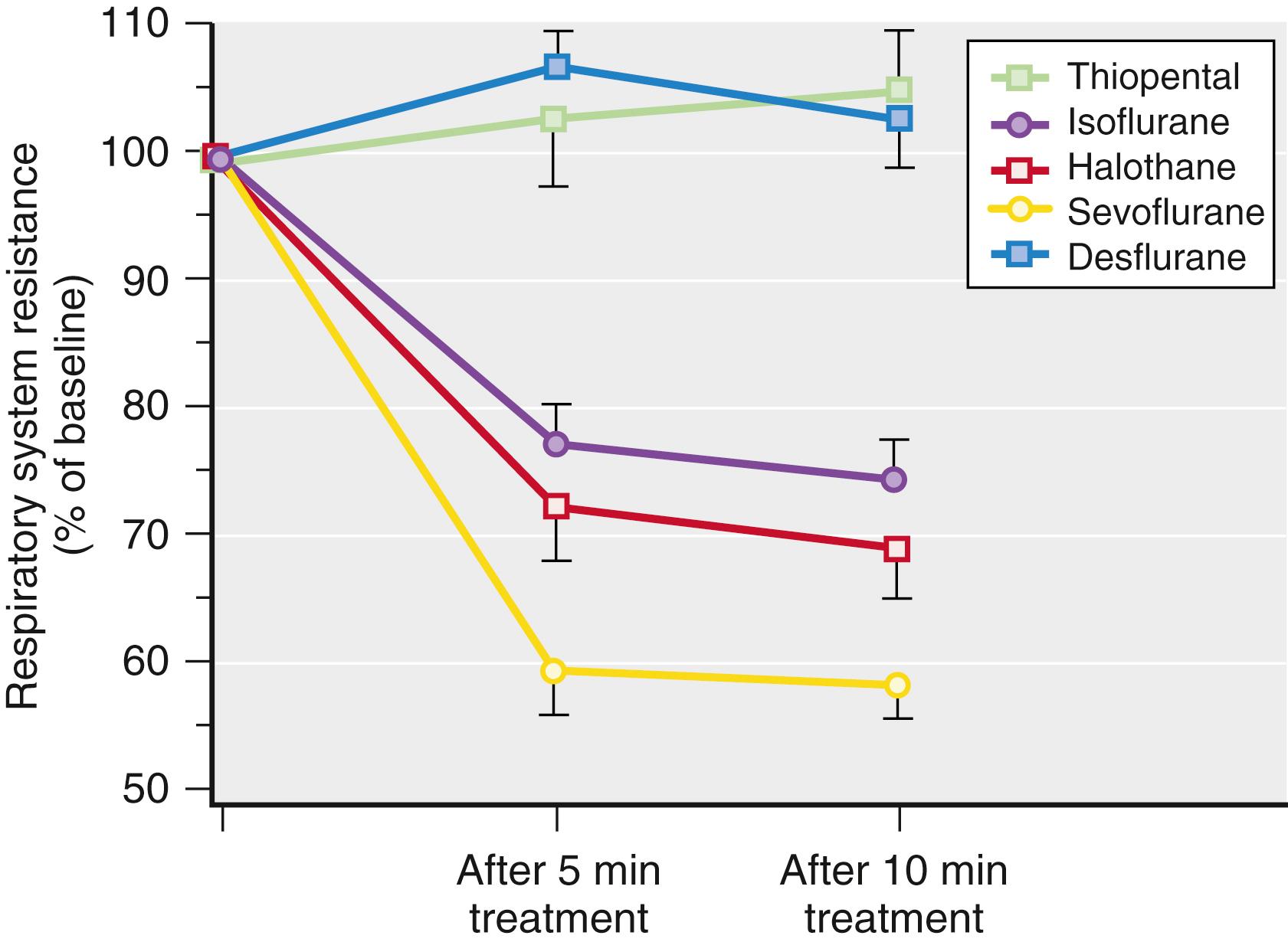
The work of breathing is defined as pressure or force multiplied by the tidal volume during inspiration. Respiratory work is further divided into elastic work (required to overcome the recoil of the lung) and resistive work (required to overcome airway flow resistance and viscoelastic resistance of pulmonary tissues). The work of breathing is usually derived from transpulmonary pressure volume curves. Volatile anesthetics increase the work of breathing in adults and children. In rats, sevoflurane reduced pulmonary compliance at the lung periphery rather than at the airway level, thereby increasing viscoelastic and elastic pressures in the lung. In addition, in a murine model of chronic asthma, sevoflurane significantly decreased resistance in central and distal airways and also lowered resistance in the lung periphery. These data suggest that sevoflurane exerts a beneficial effect in the presence of chronic airway obstruction and indicate that sevoflurane might reduce the work of breathing in comparison to other drugs ( Fig. 21.4 ).
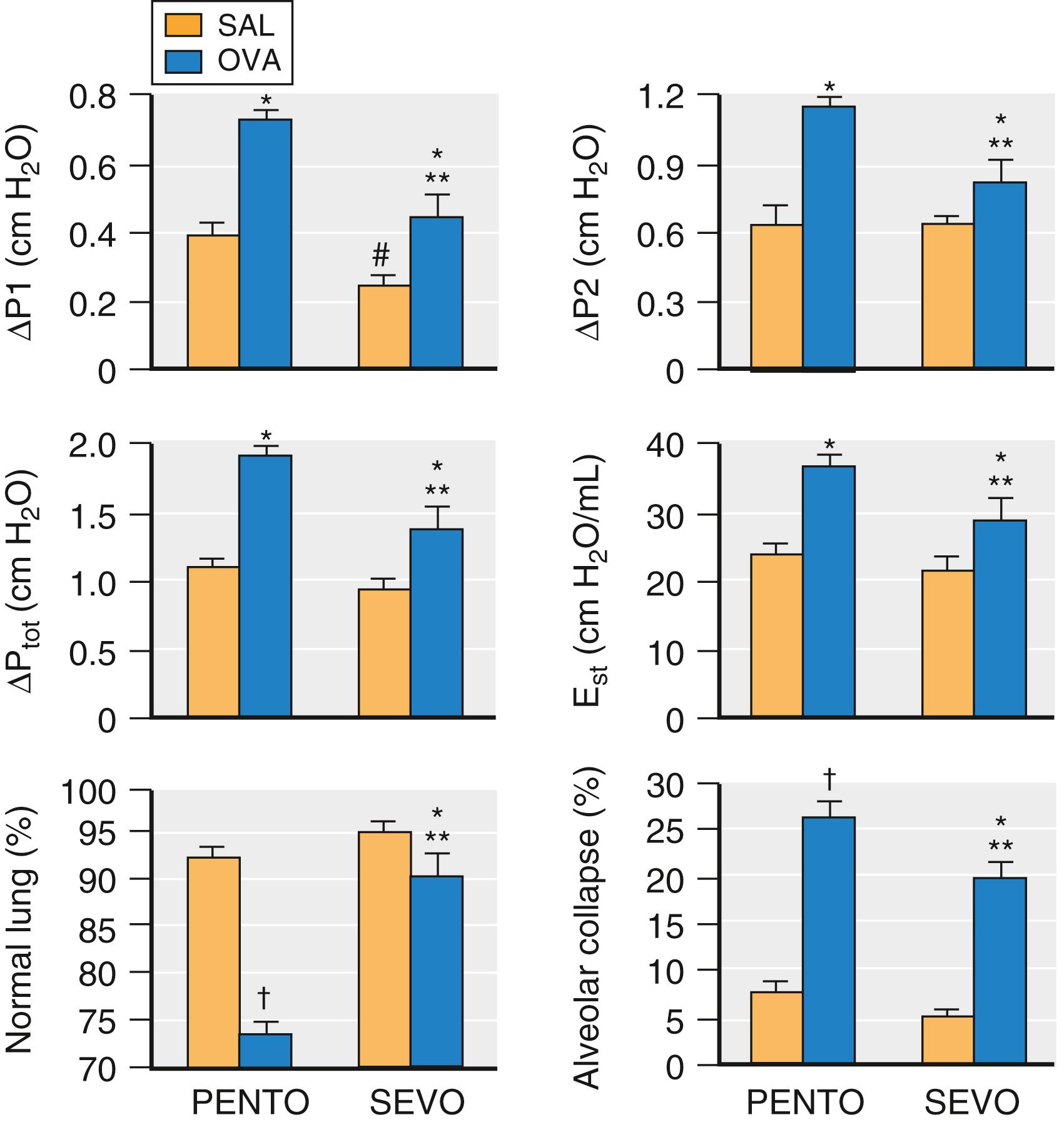
Studies in humans demonstrate a ceiling effect where low concentrations of volatile anesthetics significantly reduce upper airway resistance , reflecting changes in airway smooth muscle tone in the major airways. In contrast, distal airways and lung parenchyma lack a smooth muscle component (with lower airway and alveolar resistance being more a measure of viscoelastic changes in the lung). Increasing concentrations of inhalational agents have diminished effect on these more distal pulmonary components and thus do not further reduce total lung resistance ( Fig. 21.5 ).
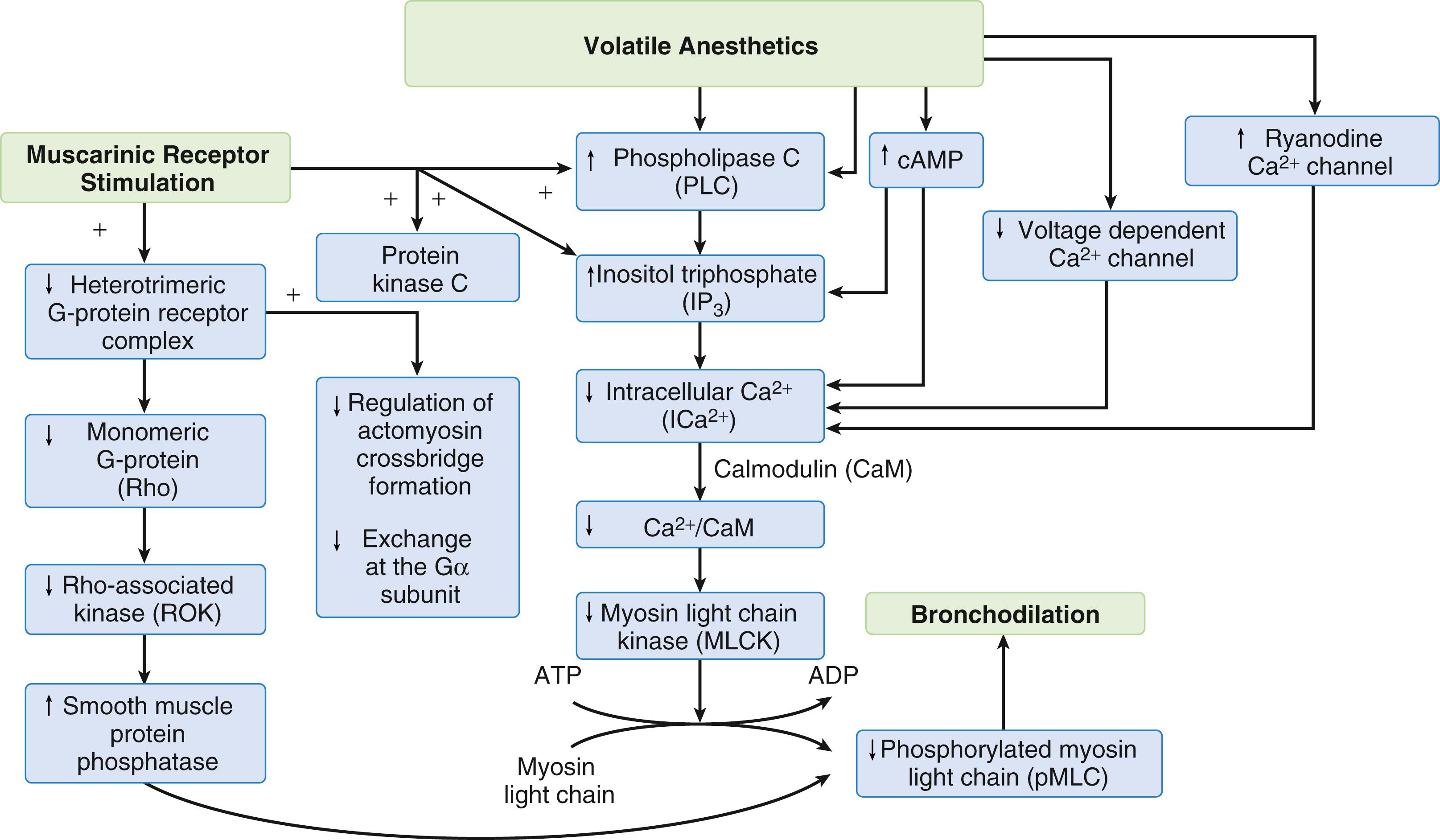
Expiration is passively affected by the recoil characteristics of the lung during normal breathing. In anesthetized patients, the ventilatory response to expiratory resistance is reduced to a greater extent than the response to inspiratory resistance. Conscious and anesthetized humans exhibit decreases in respiratory rate when expiratory resistive loads are applied, but only anesthetized subjects develop rib cage–abdominal wall motion dyssynchrony that causes less effective ventilation and reduction in minute alveolar ventilation. This concept may be particularly important in spontaneously breathing anesthetized patients who demonstrate expiratory obstruction, such as in cases of asthma, COPD, airway secretions, or during hypopharyngeal obstruction or partial breathing circuit occlusion.
Experimental studies demonstrating the equal potency of sevoflurane and isoflurane and the higher potency of halothane for bronchodilation must be extrapolated with caution because histamine-mediated experimental bronchospasm may not closely mimic tracheal intubation–induced bronchospasm in humans. Indeed, Arakawa and colleagues showed that similar inspired concentrations of halothane, isoflurane, and sevoflurane produced nearly identical reductions in airway resistance in a patient with status asthmaticus. Volatile anesthetics may thus be an effective therapeutic modality in status asthmaticus when conventional therapy has failed.
β-Adrenoceptor agonists may be beneficial for treating acute bronchospasm in patients anesthetized with halothane, but their use may not be beneficial with other volatile anesthetics. For example, the β 2 -adrenergic agonist fenoterol reduced respiratory system resistance after endotracheal intubation but did not further decrease resistance when administered in the presence of 1.3% isoflurane. These findings should be interpreted with caution because the technique used to determine respiratory system resistance incorporates alterations in lung and chest wall resistance, as well as tissue viscosity. The most important functional change that occurs in the presence of lung disease is increased resistance. Resistance to airflow is typically thought of as being determined by the flow rate and airway smooth muscle tension. However, nonmuscle elements, such as lung inflammation, airway thickening, altered lung volumes, lung recoil, airway wall remodeling, mucous hypersecretion, and loss of lung elastance, also play a clinically significant role in the amount of airway narrowing. The role of volatile anesthetics in altering many of these non–smooth-muscle elements responsible for airway resistance needs further elucidation.
The effects of volatile anesthetics on bronchomotor tone are also dependent on the substance used to produce contraction in vitro. Relaxation of tracheal smooth muscle by halothane and isoflurane is greatest in the presence of the endogenous mediator serotonin (resulting from anaphylactoid or immunologic reactions) compared with ACh (representing the neutrally derived mediator of reflex bronchospasm). Thus inhaled anesthetics may remain effective bronchodilators, even in the presence of severe serotonin- or histamine-induced bronchospasm that is refractory to β 2 -adrenoceptor therapy. It is important to note that in anesthetized patients, volatile anesthetic–induced decreases in bronchomotor tone and neurally mediated airway reflexes may be partially opposed by a simultaneous reduction in functional residual capacity (FRC). The well-known increased risk for morbidity and mortality in patients with asthma may be at least partially attributed to these FRC-mediated increases in airway resistance. Low temperature abolished the inhibitory effects of volatile anesthetics on carbachol-induced contraction of airway smooth muscle in dogs, suggesting that intraoperative hypothermia may also attenuate volatile anesthetic–induced bronchodilation.
Bronchospasm may occur in conditions and with respiratory diseases other than asthma. For example, healthy patients undergoing surgical stimulation of lung parenchyma or airways including tracheal stimulation by an endotracheal tube are at risk of developing bronchospasm. Preoperative medications, sedatives, neuromuscular blockers, and volatile anesthetics are all important factors that may trigger or attenuate bronchospasms. Regardless of the airway sensitivity prior to induction, the different pathways involved in an individual patient may yield different responses to the volatile anesthetics. Iwasaki and colleagues demonstrated that sevoflurane-induced relaxation of airway smooth muscle and VDC channels were dependent on the type of hyperreactive airway model. Sevoflurane had smaller effects in a model of chronic tobacco smoking (enlarged alveolar ducts and less muscarinic hyperreactivity), compared with an antigen-acute asthmatic (ovalbumin-sensitized) model. The morphologic changes in the peripheral airway may be responsible to some degree for a decrease in the efficacy of volatile anesthetics as bronchodilators in tobacco smokers, but sevoflurane and isoflurane still decrease respiratory system resistance in patients with COPD.
In children undergoing elective imaging studies, sevoflurane produced progressive reductions in the cross-sectional area of upper airway, resulting in pharyngeal airway collapse (also see Chapter 93). As observed with isoflurane in animal models, the effects of sevoflurane were not uniformly distributed along the upper airway. In healthy children, sevoflurane slightly decreased airway resistance, but desflurane had the opposite effect, presumably via reduced airway size. Children with documented airway susceptibility, such as those with asthma or a recent upper respiratory tract infection, exhibit significant increases in airway resistance. In these pediatric patients, desflurane should be avoided.
Volatile anesthetics attenuate airway smooth muscle tone by reducing smooth muscle contractility. This action is the result of the direct effects on bronchial epithelium and airway smooth muscle cells, combined with the indirect inhibition of reflex neural pathways. Several intracellular mediators responsible for Ca 2+ mobilization are potential sites for the action for volatile anesthetics. Inhibition of cell membrane-associated VDC channels reduces Ca 2+ entry into the cytosol. Volatile anesthetic–induced increases in cAMP concentrations cause decreases in intracellular-free Ca 2+ by stimulating Ca 2+ efflux and increasing Ca 2+ uptake into the sarcoplasmic reticular (SR). In addition, a decrease in Ca 2+ sensitivity attributable to inhibition of PKC activity, inhibition of G-protein function, and attenuation of Rho/Rho-kinase signaling pathways also play important roles. Volatile anesthetics may also alter pulmonary resistance by affecting the density of the gas mixture. In an experimental lung model of fixed pulmonary resistance, high concentrations of volatile anesthetics increased the density of the gas mixture and the calculated resistance, with desflurane producing the largest increase ( Fig. 21.6 ). Such an effect is particularly profound for 55 xenon which has a molecular weight of 131.2 Daltons, making it four times as dense as room air.
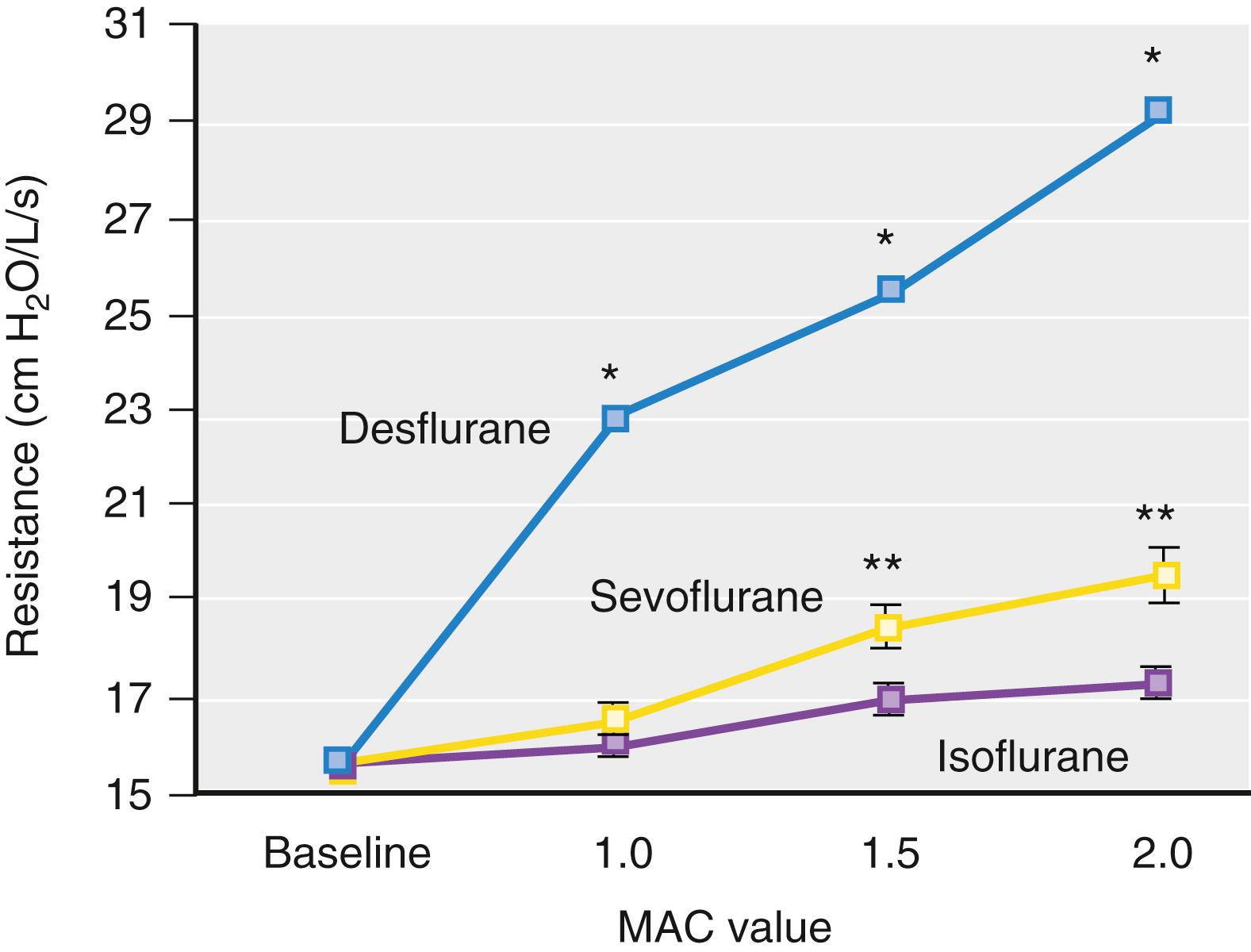
The effects of volatile anesthetics on proximal, compared with distal, airways may be related to the differential effects on VDC channels and the relative distribution of these channels. Long-lasting (L-type) VDC channels appear to be the predominant mechanism for Ca 2+ entry in tracheal smooth muscle, whereas both transient (T-type) and L-type VDC channels are present in bronchial smooth muscle. Isoflurane and sevoflurane inhibit both types of VDC channels in a dose-dependent fashion, and their effects on T-type VDC channels in bronchial smooth muscle are even more pronounced ( Fig. 21.7 ).
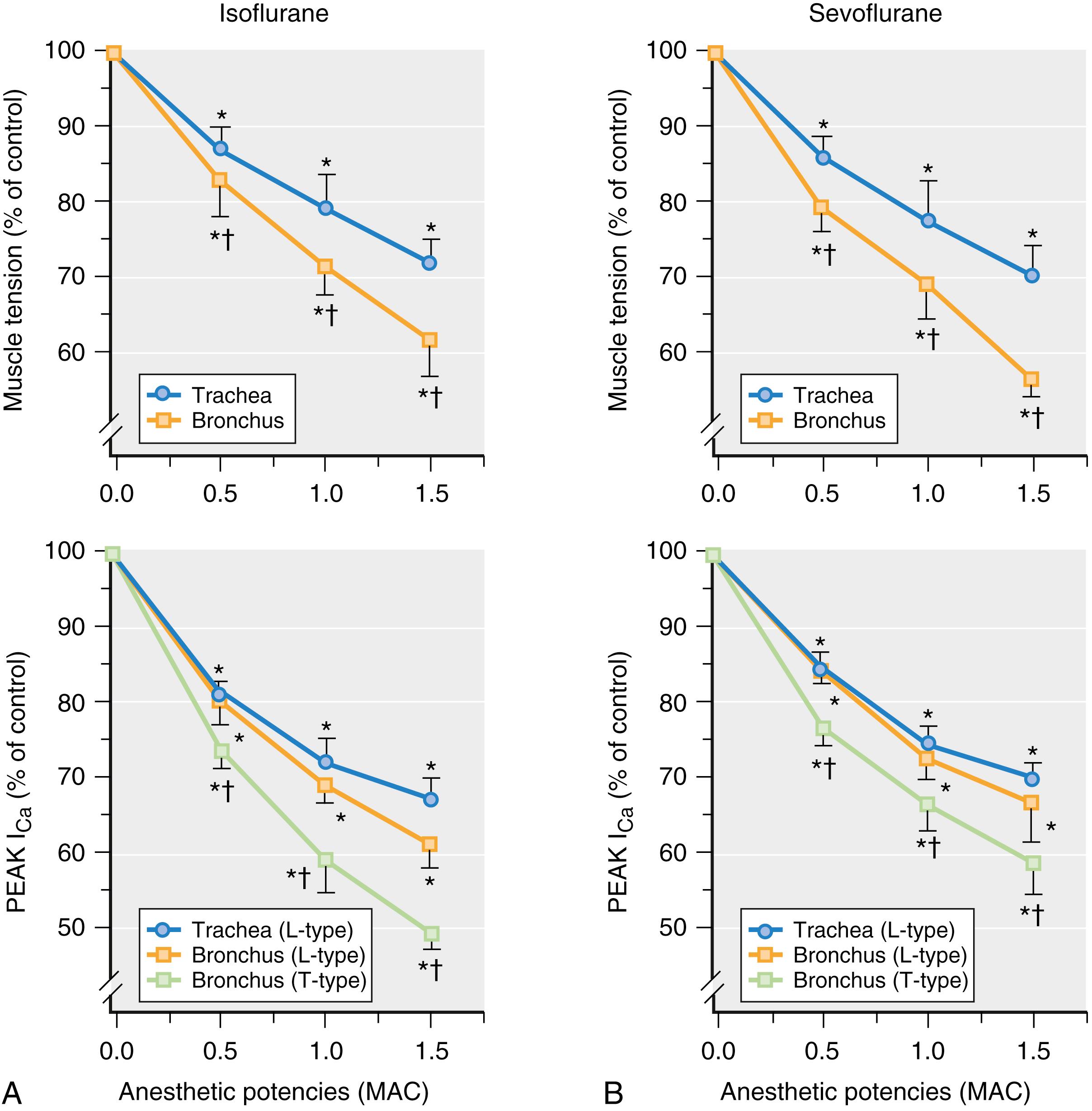
The differential effects of volatile anesthetics on tracheal smooth muscle, compared with bronchial smooth muscle, may also be related to actions on Ca 2+ -activated chloride channel activity or differential sensitivities of K + channel subtypes.
The proposed signaling pathways underlying volatile anesthetic–induced bronchodilation are depicted in Fig. 21.8 .
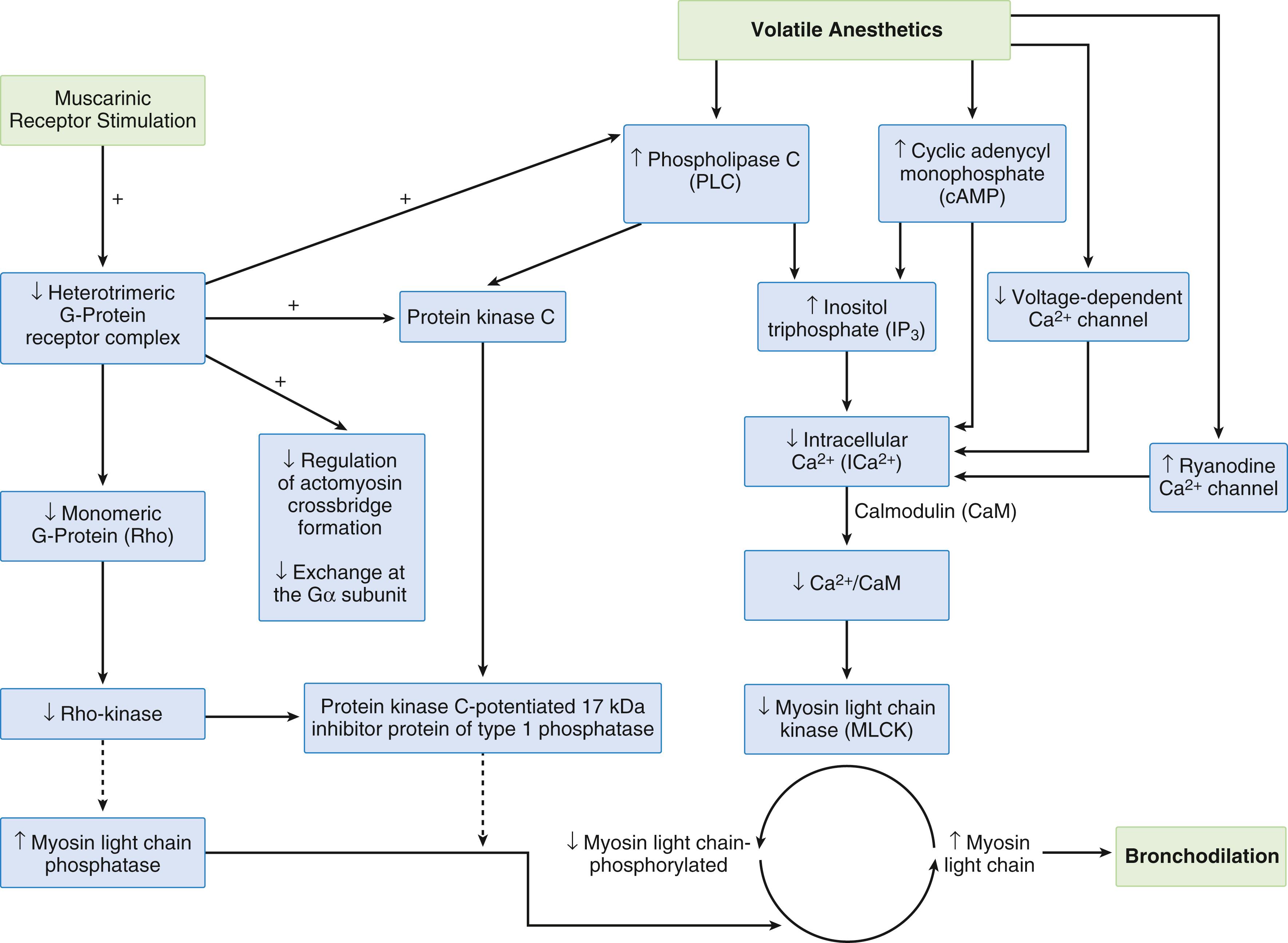
Volatile anesthetic–induced reductions in ICa 2+ result from the inhibition of both VDC and receptor-gated Ca 2+ channels. In addition, volatile anesthetics deplete Ca 2+ stores in SR by increasing Ca 2+ leakage. Ca 2+ influx occurring in response to depleted SR Ca 2+ stores is known as store-operated Ca 2+ entry (SOCE). By depleting Ca 2+ stores in SR, volatile anesthetics may be expected to enhance SOCE. Nevertheless, at clinically relevant concentrations, volatile anesthetics (isoflurane more than sevoflurane) also inhibit SOCE in airway smooth muscle to further reduce available Ca 2+ .
Volatile anesthetic–induced reductions in SR Ca 2+ appear to occur through enhancement of IP 3 and ryanodine-receptor channel activities. Kai and co-workers demonstrated that halothane attenuates ACh-induced Ca 2+ sensitization in canine tracheal smooth muscle to a greater extent than does sevoflurane, whereas isoflurane has effect at concentrations equivalent to 2 MAC. This effect appears to be mediated, at least in part, by an increase in smooth muscle protein phosphatase, modulation of G proteins (specifically G q and G I that exert actions on cyclic guanosine monophosphate [cGMP]), or modulation of the Rho/Rho-kinase signaling pathways. Volatile anesthetics interact with the muscarinic receptor–heterotrimeric G protein complex to prevent agonist-promoted nucleotide exchange at the Gα subunit of the G protein. Halothane, sevoflurane, and, minimally, isoflurane exert direct effects on muscarinic receptor–mediated contraction of isolated airway smooth muscle. The inhibitory effects of volatile agents on the biochemical coupling between the M 3 muscarinic receptor and the Gα q heterotrimeric G protein is completely reversible with time. Isoflurane-induced relaxation of precontracted bronchial smooth muscles is significantly augmented by pretreatment with a Rho-kinase inhibitor, whereas sevoflurane-inhibited guanosine-5′-triphosphate (GTP) γ S-stimulated contraction and membrane translocation of both Rho and Rho-kinase in a concentration-dependent manner. These latter actions play important roles in Ca 2+ sensitization. The final pathway in airway smooth muscle contraction is the generation of force and shortening of smooth muscles regulated by myosin cross-bridge number and kinetics. Isoflurane modulates both cross-bridge number and cycling rates of isolated rat airway smooth muscle.
The bronchodilatory effect of volatile anesthetics is also mediated by GABA A (GABA A ) receptors in the brainstem or GABA B (GABA B ) receptors on preganglionic cholinergic nerves in the lung similar to the observations with propofol. Indeed, GABA A and GABA B receptors, as well as glutamic decarboxylase (enzyme responsible for GABA synthesis), are located in airway epithelial and smooth muscle cells. GABA levels increase and localize to airway smooth muscle after contractile stimuli in upper airways. Furthermore, a GABA agonist reversed augmentation of cholinergic-induced tracheal ring contraction.
Inhaled but not intravenous halothane attenuated bronchoconstricting effects of low inhaled concentrations of CO 2 in rat distal bronchi, suggesting that halothane exerts a direct action on airway muscle tone or local neural reflex arcs rather than centrally controlled reflex pathways. Consistent with this hypothesis, halothane-, isoflurane-, sevoflurane-, and desflurane-induced dilation of distal bronchial segments is partially dependent on the presence of bronchial epithelium. Prostanoids (e.g., prostaglandin E 2 or I 2 ) or NO may be responsible for the bronchodilatory effects of volatile anesthetics under these conditions. Focal epithelial damage or inflammation may occur in small airways in patients with asthma or allergen exposure, resulting in a reduced bronchodilatory response to volatile anesthetics. Nevertheless, the most pronounced bronchodilatory action of volatile anesthetics in patients with chronic reactive airway disease occurs primarily in the proximal rather than distal airways.
Direct stimulation of intrinsic airway nerves in vitro produces a contractile response that is inhibited by atropine. Volatile anesthetic–induced bronchodilation also occurs by modulation of this airway cholinergic neural transmission mediated through prejunctional and postjunctional mechanisms. The combination of atropine and halothane did not increase airway caliber over that attained with either drug alone, suggesting that halothane dilates airways by blocking vagal tone during unstimulated conditions. Potent tracheal constriction also occurs in response to the endogenously produced endothelin-1. Isoflurane attenuated the endothelin-1–induced airway smooth muscle contraction in rat tracheal rings, suggesting another potential mechanism for airway smooth muscle relaxation.
The upward clearance of mucus from the tracheobronchial tree is responsible for removal of foreign particulate matter, microorganisms, and dead cells and is a primary pulmonary defense mechanism. Although ciliated respiratory epithelium cells are present throughout the respiratory tree, the density of ciliated respiratory epithelium progressively decreases from the trachea to the terminal bronchioles. Cilia are hair-like appendages, consisting of hundreds of proteins organized around a microtubular architecture. They are anchored to the apical cytoplasm by a basal body and extend from the cell surface into the extracellular space. Cilia are classified as either motile or immotile (primary). Motile cilia were thought to be responsible for generating extracellular fluid movement or propelling individual cells, whereas primary cilia were believed to be vestigial. However, primary cilia are important environmental sensors. In human bronchial epithelium, they play a key role in sensing and transducing extracellular mechanochemical signals and are also capable of identifying smooth muscle injury. Indeed, ciliopathies are responsible for a variety of pediatric disorders such as primary ciliary dyskinesia and autosomal recessive polycystic kidney disease. Christopher et al. studied the effects of temperature (15°C-37°C) with varying combinations with fentanyl, dexmedetomidine, and isoflurane on the cilia of mouse tracheal epithelia. There was a linear correlation between cilia motility and temperature. Fentanyl exerted stimulatory effects on cilia, while dexmedetomidine and isoflurane both inhibited cilia function. When added together, fentanyl, dexmedetomidine, and isoflurane were all cilia inhibitory. In contrast, fentanyl plus dexmedetomidine did not significantly alter ciliary function, with results suggesting complex drug-drug and drug-temperature interactions not predicted by simple summation of effects.
Ciliary motion consists of a rapid stroke in a cephalad direction, followed by a slower caudal recovery stroke. Movements of cilia are closely coordinated to move matter efficiently toward the trachea in a wave motion known as metachronism . Each motile cilium is organized in nine peripheral microtubule pairs surrounding a central pair (9+2). During a beat, dynein arms undergo an adenosine triphosphate (ATP)–dependent attachment, retraction, and release cycle with the adjacent doublet, which results in a sliding motion. The basal bodies of the motile cilia are anchored to the microtubules, nexin links, and radial spokes and are further restricted by the ciliary membrane. This anatomic constraint converts the sliding motion into a bend.
The quantity and physical properties of the mucous layer may also promote the coordination of ciliary beats. Mucus is a mixture of water, electrolytes, and macromolecules (e.g., lipids, mucins, enzymes) secreted by goblet cells and mucosal glands. Thicker layers of mucus slow the removal of surface particles from the airway, whereas low-viscosity mucus promotes more rapid ciliary transport. Impaired mucociliary function in the upper airways correlates with low levels of nasal NO, although the clinical significance of this finding is unclear. Direct nervous system control of ciliary coordination has not been demonstrated in vertebrates, but mucociliary clearance is closely related to autonomic nervous system activity, most likely related to changes in physical characteristics of respiratory secretions (also see Chapter 103).
Several factors affect mucociliary function in mechanically ventilated patients contributing to lung atelectasis and hypoxemia. For example, insufficiently humidified inspired gases reduce ciliary movement and desiccate mucus. In dogs, the flow rate of tracheal mucous was maintained within the basal range during a 40-minute exposure to inspired dry air at a temperature higher than 32°C. However, 3 hours of inhalation of dry air caused a complete cessation of the flow of tracheal mucus, which was restored by the subsequent use of inspired gases with 100% relative humidity at 38°C. Several anesthesia-related factors also reduce the rate of mucous movement, including high-inspired oxygen (O 2 ) concentrations, adjuvant medications (e.g., corticosteroids, atropine, β-adrenoreceptor antagonists) that affect bronchial tone, the presence of an endotracheal tube, and positive-pressure ventilation.
Volatile anesthetics and nitrous oxide diminish the rates of mucous clearance by decreasing ciliary beat frequency, disrupting metachronism, and altering the physical characteristics or quantity of mucus. In contrast to many intravenous anesthetics, halothane, enflurane, isoflurane, and sevoflurane all reduce ciliary movement and beat frequency in vitro. Among the volatile anesthetics, sevoflurane exhibited the weakest cilioinhibitory effects in rat cultured tracheal epithelial cells in vitro ( Fig. 21.9 ).
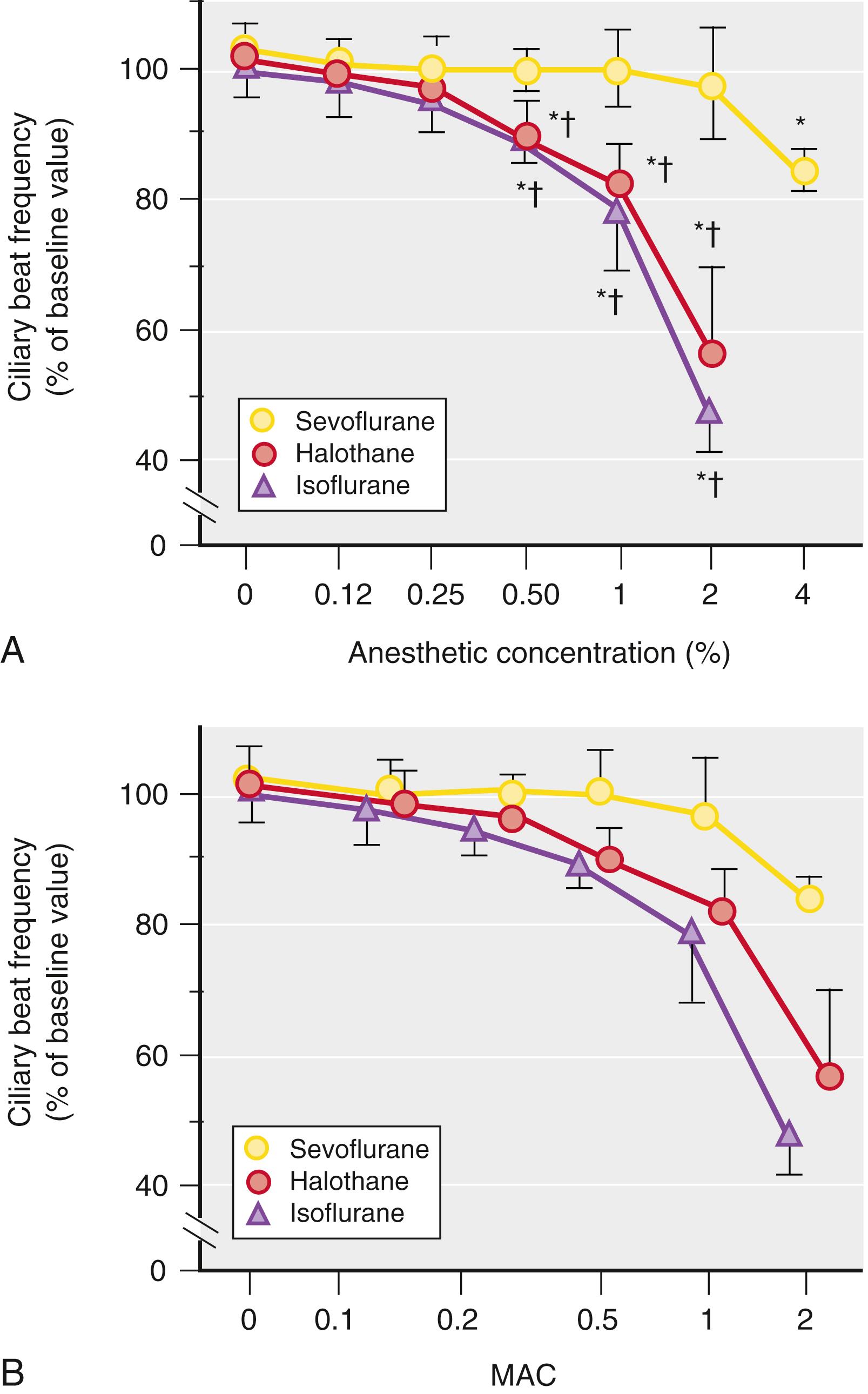
Gamsu and colleagues measured the rate of tantalum (a powder that adheres to airway mucus) clearance from the lungs of postoperative patients who received general anesthesia for intraabdominal or lower extremity surgeries. Tantalum retention was closely correlated with the retention of mucus and shown for as long as 6 days after intraabdominal surgery. The administration of halothane (1%-2%) and nitrous oxide (60%) rapidly decreased the rate of mucous movement in females undergoing gynecologic surgery. Little or no mucous motion was observed after 90 minutes of halothane–nitrous oxide inhalation. Bronchial mucosal transport velocity was also determined using radiolabeled albumin microspheres distally deposited in the mainstem bronchi using a fiberoptic bronchoscope in healthy patients. In contrast to the findings of the study with halothane, mucous velocity was unchanged during the administration of 1.5 MAC isoflurane.
Impairment of ciliary beat frequency, mucociliary clearance, and bronchial mucous transport contribute to pulmonary complications, including retention of secretions, atelectasis, and lower respiratory tract infection. A reduction in bronchial mucous transport of as little as 3.5 mm/min (normally 10 mm/min) was associated with an increase in pulmonary complications in patients who were mechanically ventilated for 4 days in the intensive care unit (ICU). Thus pulmonary therapy directed at enhancing clearance of secretions from the airways may be beneficial in the immediate postoperative period, regardless of the type of volatile anesthetic chosen.
Compared to nonsmokers, tobacco smokers have significantly slower bronchial mucous transport velocities and are prone to more frequent pulmonary complications when undergoing major abdominal or thoracic surgeries. The specific effects of volatile anesthetics on mucous movement in smokers have not been well studied. However, it is likely that an additive or synergistic negative effect on mucous transport may be present. Impairment of mucociliary function also occurs after lung transplantation. The mechanism for this dysfunction may be related to alterations in the surface properties of mucus and significant impairment of mucociliary transport distal to bronchial transection and re-anastomosis. The effects of volatile anesthetics on mucous transport in lung transplant patients have not been described, but the baseline reductions in mucociliary movement would certainly predispose to postoperative respiratory complications.
Pulmonary surfactant decreases the work of breathing by reducing surface tension at the fluid-gas interface. Surfactant is a mixture of proteins and phospholipids synthesized by alveolar type II cells. Similar to mucus, surfactant plays a role in removing foreign particles from airways while also enhancing the bactericidal actions of alveolar macrophages. Halothane and isoflurane produced a transient dose-dependent reduction in phosphatidylcholine (a major component of surfactant) synthesis by alveolar cells during a 4-hour exposure. High concentrations of halothane also disrupted the energy metabolism of cultured alveolar cells as indicated by reduced ATP content and enhanced glycolytic metabolism. Halothane and isoflurane potentiated a hydrogen peroxide–induced reduction of phosphatidylcholine content in alveolar type II cells by affecting cell energetics. Halothane decreased the Na + /K + –adenosine triphosphatase (Na + /K + -ATPase), and Na + channel activity in alveolar type II cells, probably related to alterations in ICa 2+ or ATP depletion. A similar decrease in type II alveolar cell Na + /K + -ATPase occurs after the administration of isoflurane. Transepithelial Na + transport helps regulate alveolar fluid balance, and, as a result, impairment of this transport system may contribute to alveolar edema. This observation may be especially relevant in surgical patients because volatile anesthetics decrease alveolar epithelial fluid clearance.
The phospholipid composition of surfactant is critical to its functional integrity. Another crucial component of surfactant is the hydrophobic surfactant-associated protein C synthesized by alveolar type II cells. This protein facilitates the adsorption and spreading of phospholipids to form the surfactant monolayer and enhances the lipid uptake into alveolar type II cells. Exogenous surfactants that contain surfactant-associated protein C are effective at decreasing barotrauma and mortality in vivo. Clinically relevant concentrations of halothane increase surfactant-associated protein C messenger ribonucleic acid (mRNA) in vitro but cause the opposite effect in mechanically ventilated rats. Extrapolation of these findings to patients should be approached with caution, but halothane and mechanical ventilation may play a potentially additive and deleterious role on surfactant production and homeostasis of the alveolar space, particularly in the presence of ALI. In a rat model, sevoflurane produced deterioration in surfactant composition and viscosity with impaired lung mechanics promoting alveolar collapse ; again, caution is warranted in extrapolating these findings to humans. Bilgi and colleagues compared the effects of low-flow and high-flow inhalational anesthesia with nitrous oxide and desflurane on mucociliary activity and pulmonary function tests in humans. The forced vital capacity and forced expiratory volume and mucociliary clearance of saccharin powder were better preserved with low-flow rather than a high-flow technique, suggesting that heated and humidified gases may have a greater impact than the inhaled anesthetics themselves.
Prolonged administration of volatile anesthetics may produce mucous pooling and impair alveolar cell surfactant metabolism. These actions may result in adverse effects on pulmonary function including development of atelectasis and infections. Patients with excessive or abnormal mucous or surfactant production and patients with ALI, chronic bronchitis, asthma, cystic fibrosis, and chronic mechanical ventilation are at the greatest risk. Clinical studies of the effects of volatile anesthetics on mucociliary function, surfactant metabolism, and immunomodulation in patients with compromised pulmonary function are still sparse.
The pulmonary vascular bed is a low-pressure, high-flow system. Normal pulmonary arterial (PA) pressure is approximately one-fifth of the systemic arterial pressure. Correspondingly, PVR is lower than systemic vascular resistance. The main pulmonary artery and its major branches have a thinner media and less vascular smooth muscle than the aorta and major proximal arterial vessels. Changes in pulmonary vascular smooth muscle tone alter PVR by affecting the slope of pressure-flow relation. Such direct changes may be produced by a rapid rise in cytoplasmic ICa 2+ of the pulmonary vascular smooth muscle cell or by alterations in sympathetic nervous system activity, arterial O 2 and CO 2 tension, acid-base balance, or plasma catecholamine concentrations. Hypercapnia at constant pH (i.e., isohydria) does not alter tone in isolated pulmonary arteries, but normocapnic acidosis relaxes isolated pulmonary arteries by an endothelium-independent mechanism. However, pulmonary endothelial dysfunction potentiates hypercapnia-induced vasoconstriction. Changes in PA pressure and PVR exert important effects on pulmonary gas or fluid exchange. An increase in PVR occurring in conjunction with a corresponding increase in PA pressure promotes interstitial fluid transudation. An acute increase in PVR can be caused by large tidal volumes, high positive end-expiratory pressure, alveolar hypoxia, hypercarbia, acidosis, and critical closing pressure. Hypoxia and acidosis have a synergistic effect increasing PVR. In contrast to acute pulmonary hypertension, the development of chronic pulmonary hypertension involves endothelial dysfunction with persistent vasoconstriction due to imbalance between endogenous vasoconstrictors (including thromboxane A 2 , angiotensin 2, and endothelin 1) and vasodilators (including NO and prostacyclin), smooth muscle proliferation, platelet aggregation, vascular remodeling and thrombosis, and formation of plexiform lesions that irreversibly obliterate pulmonary arterioles. Clinically, the use of positive inotropic medications (e.g., milrinone) or expanded blood volume can passively decrease PVR by increasing cardiac output. Volatile anesthetics may also have indirect effects on PVR through a reduction in lung volumes during spontaneous ventilation. To assess the total effect of the volatile anesthesia, the volume status and mechanical ventilation on the pulmonary pressures, and right heart function, either transthoracic or transesophageal echocardiography should be considered.
Endogenously produced NO plays an important role in the regulation of PVR both in the healthy, normoxic lung and during hypoxia. NO is generated via oxidation of a terminal guanidinium nitrogen on the amino acid L-arginine. The reaction utilizes molecular O 2 and NADPH as substrates, requires the presence of tetrahydrobiopterin, flavoproteins, calmodulin, and thiols as cofactors, and yields NO in addition to the co-product L-citrullin. This oxidation is catalyzed by a single enzyme protein, NO synthase (NOS), which exists in three distinct isoforms. Constitutive calcium-dependent isoforms of the enzyme were originally purified from neuronal tissue (nNOS) and vascular endothelium (eNOS). When stimulated by bacterial endotoxin and proinflammatory cytokines, a third calcium-independent isoform (iNOS) is induced in various cell types including endothelial and vascular smooth muscle cells, macrophages, and fibroblasts. Once expressed, iNOS is independent of calcium, and NO production continues at a maximum rate. All three NOS isoforms are widely distributed in the lung, extensively involved in vascular homeostasis, and intimately linked to the pulmonary O 2 environment.
NO diffuses away from its point of synthesis and interacts with various intracellular molecular sites both within the generating cells and the target cells. The best-characterized target for NO is iron, bound within certain proteins, either as a heme group or as an iron-sulfur complex. The interaction of NO with the heme component of soluble guanylate cyclase stimulates enzymatic conversion of guanosine triphosphate to cGMP. In turn, increased intracellular levels of cGMP cause relaxation of systemic and pulmonary vascular and nonvascular smooth muscles by several mechanisms. Besides lowering free intracellular calcium and attenuating calcium transients, cGMP causes hyperpolarization of muscle cells through activation of potassium channels.
Inhalation of gaseous NO produces selective pulmonary vasodilation in well-ventilated lung areas and may be beneficial in the treatment of neonatal pulmonary hypertension resulting from a variety of congenital heart diseases, hypoplastic lung, and meconium aspiration. Inhaled NO has also some benefits in the treatment of acute pulmonary hypertension in adults, provided that the PVR is not fixed by remodeling and hypertrophy of pulmonary vasculature. Additionally, the use of inhaled NO to reduce PVR in pediatric and adult patients during cardiac surgeries has become common (also see Chapters 67, 94, and 104).
Prostacyclin is another endogenous vasodilator produced by the endothelium that causes smooth muscle relaxation through adenylyl cyclase stimulation and production of cAMP. Prostacyclin is used in inhaled or injected formulations to produce pulmonary vasodilation in patients with chronic PA hypertension. Another group of pulmonary vasodilators, including sildenafil and tadalafil, acts by inhibiting cGMP-specific phosphodiesterase type 5 (an enzyme that is responsible for cGMP degradation) and is used for therapy of refractory PA hypertension. Finally, riociguat, a novel drug that directly stimulates soluble guanylate cyclase independently of NO, has been recently approved for treating patients with chronic pulmonary hypertension and chronic thromboembolic pulmonary hypertension.
Become a Clinical Tree membership for Full access and enjoy Unlimited articles
If you are a member. Log in here